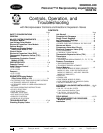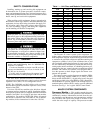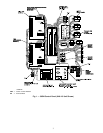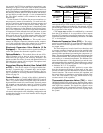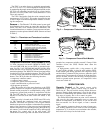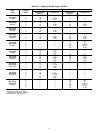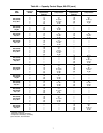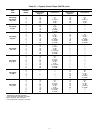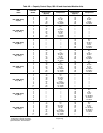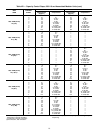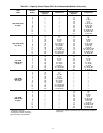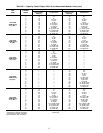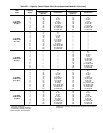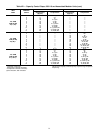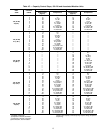
also controls the EXV driver module (as appropriate), com-
manding it to open or close each EXV in order to maintain
the proper superheat entering the cylinders of each lead com-
pressor. Information is transmitted between the processor mod-
ule and relay module, the EXV driver module, and the key-
pad and display module through a 3-wire communications
bus. The options module is also connected to the commu-
nications bus.
For the Flotronic™ II chillers, the processor monitors sys-
tem pressure by means of 6 transducers, 3 in each lead com-
pressor. Compressor suction pressure, discharge pressure, and
oil pressure are sensed. If the processor senses high dis-
charge pressure or low suction pressure, it immediately shuts
down all compressors in the affected circuit. During opera-
tion, if low oil pressure is sensed for longer than one minute,
all compressors in the affected circuit are shut down. At start-
up, the oil pressure signal is ignored for 2 minutes. If shut-
down occurs due to any of these pressure faults, the circuit
is locked out and the appropriate fault code is displayed.
Low-Voltage Relay Module — This module closes
contacts to energize compressor unloaders and/or compres-
sors. It also senses the status of the safeties for all compres-
sors and transmits this information to the processor.
Electronic Expansion Valve Module (If So
Equipped) —
This module receives signals from the pro-
cessor and operates the electronic expansion valves.
Options Module — This module allows the use of Flo-
tronic II features such as dual set point, remote reset, de-
mand limit, hot gas bypass, and accessory unloaders. The
options module also allows for reset and demand limit to be
activated from a remote 4-20 mA signal. The options mod-
ule is installed at the factory.
Keypad and Display Module (Also Called HSIO
or LID) —
This device consists of a keypad with 6 func-
tion keys, 5 operative keys, 12 numeric keys, and an alpha-
numeric 8-character LCD (liquid crystal display). Key us-
age is explained in Accessing Functions and Subfunctions
section on page 24.
Control Switch — Control of the chiller is defined by
the position of the LOCAL/ENABLE-STOP-CCN switch.
This is a 3-position manual switch that allows the chiller to
be put under the control of its own Flotronic II controls, manu-
ally stopped, or put under the control of a Carrier Comfort
Network (CCN). Switch allows unit operation as shown in
Table 2.
In the LOCAL/ENABLE position, the chiller is under lo-
cal control and responds to the scheduling configuration and
set point data input at its own local interface device (keypad
and display module).
Table 2 — LOCAL/ENABLE-STOP-CCN
Switch Positions and Operation
SWITCH
POSITION
UNIT
OPERATION
CONFIGURATION AND
SET POINT CONTROL
Keypad Control CCN Control
STOP Unit Cannot Run Read/Write Read Only
LOCAL/ENABLE Unit Can Run Read/Limited Write Read Only
CCN Stop — Unit Cannot Run Read Only Read/Write
Run — Unit Can Run Read Only
Read/Limited
Write
In the CCN position, the chiller is under remote control
and responds only to CCN network commands. The occupied/
unoccupied conditions are defined by the network. All key-
pad and display functions can be read at the chiller regard-
less of position of the switch.
CCN run or stop condition is established by a command
from the CCN network. It is not possible to force outputs
from the CCN network, except that an emergency stop com-
mand shuts down the chiller immediately and causes ‘‘ALARM
52’’ to be displayed.
Electronic Expansion Valve (EXV) — The micro-
processor controls the EXV (if so equipped) through the EXV
driver module. Inside the expansion valve is a linear actua-
tor stepper motor.
The lead compressor in each circuit has a thermistor and
a pressure transducer located in the suction manifold after
the compressor motor. The thermistor measures the tem-
perature of the superheated gas entering the compressor cyl-
inders. The pressure transducer measures the refrigerant pressure
in the suction manifold. The microprocessor converts the pres-
sure reading to a saturated temperature. The difference be-
tween the temperature of the superheated gas and the satu-
ration temperature is the superheat. The microprocessor controls
the position of the electronic expansion valve stepper motor
to maintain 30 F (17 C) superheat.
At initial unit start-up, the EXV position is at zero. After
that, the microprocessor keeps accurate track of the valve
position in order to use this information as input for the other
control functions. The control monitors the superheat and
the rate of change of superheat to control the position of the
valve. The valve stroke is very large, which results in very
accurate control of the superheat.
Thermostatic Expansion Valves (TXV) — Model
30GN040 and 045 units with factory-installed brine option
are equipped with conventional thermostatic expansion valves
with liquid line solenoids. The liquid line solenoid valves
are not intended to be a mechanical shut-off. When service
is required, use the liquid line service valve to pump down
the system.
4



